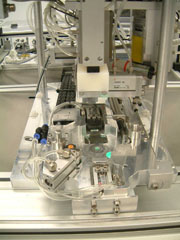The global market for drug delivery devices is forecast to exceed US$22bn by 2017, with inhaler devices expected to account for more than 96% of this figure (GBI Research, 2011). A global increase in respiratory diseases such as asthma and chronic obstructive pulmonary disease (COPD), combined with the need for further improvements in drug efficacy has resulted in market growth for speciality drug delivery devices. In line with this is the need to support the development of double-blind clinical trials within these therapeutic areas that use inhalers as the mechanism for drug delivery.
In the development of any new drug inhalation product, companies are required to run comparative trials against the market-leading products. The blinding of inhaler devices is one of the most complex areas in clinical study execution because of their unique designs. To overcome this, companies often used a double-blind, double-dummy study design to enable them to use their product in its planned market form.
A mid-sized pharmaceutical sponsor company was planning to enter Phase II trials with a promising new treatment for asthma and COPD. The clinical team had designed a double-blind clinical trial to eliminate bias. While manufacturing the active and placebo forms of their own product was relatively straightforward, developing a method to blind their product against the visually different, active comparator was more complicated and the company approached Almac to help it solve this problem.
The solution
Within a limited timeframe Almac was able to develop and validate a cost-effective, reliable blinding method capable of handling the volumes required to support the planned clinical trial demand. Based on the major visual differences between the two products, it was suggested that a double-blind, double-dummy design in which the patients received two inhalers each containing either active innovator and placebo comparator product or placebo innovator product and active comparator.

Specialised equipment was needed to successfully blind the inhalers
To enable this approach the Almac team had to develop a method to convert the commercial active comparator units to placebo. Initially, they researched the manufacturing process used for the comparator product to identify the equipment used to commercially fill the inhaler units – but determined that the cost of investing in similar equipment to support the smaller clinical trial volumes needed was too high and the rights to the filling process where also owned by the manufacturer.
The main challenge was to develop a cost-effective method that would enable the commercial comparator inhalers to be disassembled without causing them any damage, remove the blister strip containing the active pharmaceutical ingredient (API), manufacture matching placebo blister strips, develop a method for inserting these into the inhaler body and then re-assemble the inhaler without affecting its functionality.
Alongside this, Almac had to develop analytical testing methods that would support the absence of active testing. It also had to identify and source a placebo powder with similar characteristics to the API blend and to perform a stability programme for the placebo units.
A multi-functional project team consisting of experts from several disciplines was assembled to support the development of the placebo inhalers. Utilising their knowledge and expertise they developed:
- A blister line and powder filling technique that enabled the replication of the active blisters.
- Specialised equipment to disassemble and reassemble the commercial inhalers – including winding placebo blisters back into the inhaler units at the correct tension to support the functioning of the unit once fully reassembled.
- Analytical testing methods to test for the absence of active and ensure stability of the product.
- In-process validation and finished product tests to guarantee finished product functionality.
In summary, over the duration of the clinical study several thousands of placebo units were produced for use, and the feedback on the performance of these units in the field was reported as excellent. Since the development of this innovative method, more than half a million placebo units of this type have been produced for a number of clinical trials involving a diverse global client range.




